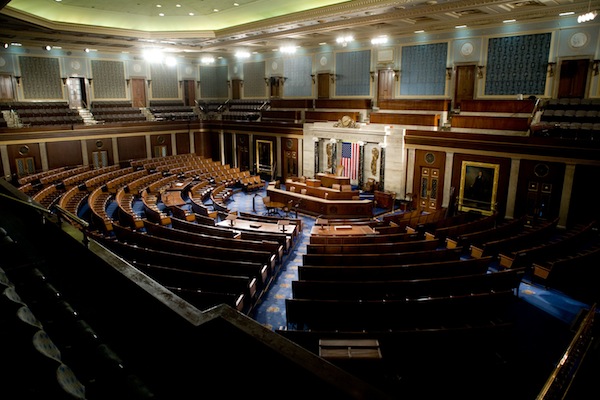A couple of weeks ago, I took a look at the tight battle for control of the United States Senate. This week: the House of Representatives. The fight for the lower chamber of Congress is much harder to assess. There are, after all, 435 individual contests — each with its own unique candidates, characteristics and electorate — compared to the 33 Senate races. At the moment, Republicans have a strong majority, holding 242 seats (if you include the Michigan one recently vacated by Thad McCotter) to the Democrats’ 193 (including two vacancies). After a terrible set of results in the 2010 midterms, the Democrats have a mountain to climb to retake control and reinstall Nancy Pelosi as Speaker.
The ‘generic Congressional ballot’ — where pollsters ask voters across the country which party’s candidate they’d vote for in their district — is currently exactly tied, according to the Realclearpolitics average. You might expect, therefore, that the two parties should be on to win roughly equal numbers of seats and therefore have roughly equal chances of emerging with a majority. But there are several reasons why the Republicans are in fact the clear favourites to retain control.
The main one is the advantage of incumbency. The New York Times’s Nate Silver has found that ‘the incumbent party in the House over-performs its vote share in terms of the number of seats it carries because of the way the vote is distributed from district to district’. Take, for example, the 1996 elections. The Democrats secured the most votes (by 272,708) but the Republicans — who had taken control of the House two years earlier — won 19 more seats. It is possible that incumbency could prove less of a benefit this year, when Congress’s approval rating is at rock bottom. But the incumbency advantage usually involves a fundraising advantage, and so it is proving this time. Republican candidates for the House have raised $445 million so far, compared to the Democrats’ $325 million.
A seat-by-seat analysis also indicates a GOP advantage. By my count (based on the dynamics of each race, what polling there is and other pundits’ predictions), Republicans have 188 safe seats against the Democrats’ 154. Of the 93 competitive races, Republicans currently hold 51, Democrats hold 32 and 10 are new seats created as the result of redistricting. To take control of the House, the Democrats would have to win 64 of them. As things stand, they’d do well to break 50. Right now, only 31 of those 93 seats look more likely to go Democrat than Republican, with 45 favouring the GOP and 17 tossups. That would suggest the Democrats’ net gain will be in the single figures, rather than the 25 they need for a majority.
My (crude) analysis points towards the Democrats winning about 45 of the 93 competitive races, which would represent a net gain of just six seats and leave them on 199 to the Republicans’ 236. The University of Virginia’s Center for Politics predicts ‘a Democratic gain of somewhere between five and ten seats, with a specific guess of Democrats plus six’, while the Rothenberg Political Report says ‘A Democratic gain in the single digits is most likely, but anything from +1 GOP to +6 Dem is possible.’
So while the Democrats can probably look forward to a better vote share this year than in 2010, when they lost to the Republicans by 6.6 points, they can’t count on turning that improvement into a significant gain in seats. For sure, the battle for the House of Representatives is nowhere near as finely-balanced as the one for control of the Senate.






Comments